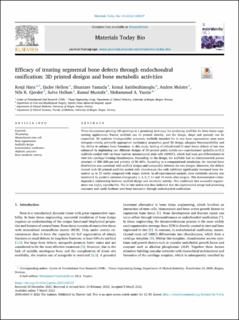| dc.contributor.author | Hara, Kenji | |
| dc.contributor.author | Hellem, Endre | |
| dc.contributor.author | Yamada, Shuntaro | |
| dc.contributor.author | Sariibrahimoglu, Kemal | |
| dc.contributor.author | Mølster, Anders | |
| dc.contributor.author | Gjerdet, Nils Roar | |
| dc.contributor.author | Hellem, Sølve | |
| dc.contributor.author | Mustafa, Kamal Babikeir Elnour | |
| dc.contributor.author | Yassin, Mohammed Ahmed Alamin Yousif | |
| dc.date.accessioned | 2023-01-02T08:48:28Z | |
| dc.date.available | 2023-01-02T08:48:28Z | |
| dc.date.created | 2022-03-18T15:51:29Z | |
| dc.date.issued | 2022 | |
| dc.identifier.issn | 2590-0064 | |
| dc.identifier.uri | https://hdl.handle.net/11250/3040202 | |
| dc.description.abstract | Three-dimensional printing (3D printing) is a promising technique for producing scaffolds for bone tissue engineering applications. Porous scaffolds can be printed directly, and the design, shape and porosity can be controlled. 3D synthetic biodegradable polymeric scaffolds intended for in situ bone regeneration must meet stringent criteria, primarily appropriate mechanical properties, good 3D design, adequate biocompatibility and the ability to enhance bone formation. In this study, healing of critical-sized (5 mm) femur defects of rats was enhanced by implanting two different designs of 3D printed poly(l-lactide-co-ε-caprolactone) (poly(LA-co-CL)) scaffolds seeded with rat bone marrow mesenchymal stem cells (rBMSC), which had been pre-differentiated in vitro into cartilage-forming chondrocytes. Depending on the design, the scaffolds had an interconnected porous structure of 300–500 μm and porosity of 50–65%. According to a computational simulation, the internal force distribution was consistent with scaffold designs and comparable between the two designs. Moreover, the defects treated with 3D-printed scaffolds seeded with chondrocyte-like cells exhibited significantly increased bone formation up to 15 weeks compared with empty defects. In all experimental animals, bone metabolic activity was monitored by positron emission tomography 1, 3, 5, 7, 11 and 14 weeks after surgery. This demonstrated a time-dependent relationship between scaffold design and metabolic activity. This confirmed that successful regeneration was highly reproducible. The in vitro and in vivo data indicated that the experimental setups had promising outcomes and could facilitate new bone formation through endochondral ossification. | en_US |
| dc.language.iso | eng | en_US |
| dc.publisher | Elsevier | en_US |
| dc.rights | Navngivelse 4.0 Internasjonal | * |
| dc.rights.uri | http://creativecommons.org/licenses/by/4.0/deed.no | * |
| dc.title | Efficacy of treating segmental bone defects through endochondral ossification: 3D printed designs and bone metabolic activities | en_US |
| dc.type | Journal article | en_US |
| dc.type | Peer reviewed | en_US |
| dc.description.version | publishedVersion | en_US |
| dc.rights.holder | Copyright 2022 The Author(s) | en_US |
| dc.source.articlenumber | 100237 | en_US |
| cristin.ispublished | true | |
| cristin.fulltext | original | |
| cristin.fulltext | original | |
| cristin.qualitycode | 1 | |
| dc.identifier.doi | 10.1016/j.mtbio.2022.100237 | |
| dc.identifier.cristin | 2010906 | |
| dc.source.journal | Materials Today Bio | en_US |
| dc.identifier.citation | Materials Today Bio. 2022, 14, 100237. | en_US |
| dc.source.volume | 14 | en_US |

